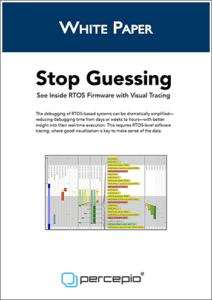Percepio Tracealyzer – Stop Guessing with Visual Trace Diagnostics
Video: Demo and Features (5 min)
Video: Benefits and Examples (14 min)
Tracealyzer can be used side-by-side with traditional debuggers, such as IAR, Keil or Eclipse tools, and complements the detailed debugger view with several additional views on system level, ideal for understanding real-time issues where a classic debugger is not sufficient.
 “Tracealyzer has always offered exceptional value to our global community of users by giving engineers direct insight into how their applications are executing. This information is invaluable when both optimizing and debugging FreeRTOS applications.”
“Tracealyzer has always offered exceptional value to our global community of users by giving engineers direct insight into how their applications are executing. This information is invaluable when both optimizing and debugging FreeRTOS applications.”
— Richard Barry, FreeRTOS founder
![]() “Percepio Tracealyzer enables unparalleled insight into the execution, timing and interactions of the RTX5 real-time operating system, the MDK middleware components and the user application. Percepio is the first ARM partner to utilize our new Event Recorder technology, which provides time deterministic high-speed access to a running target system.”
“Percepio Tracealyzer enables unparalleled insight into the execution, timing and interactions of the RTX5 real-time operating system, the MDK middleware components and the user application. Percepio is the first ARM partner to utilize our new Event Recorder technology, which provides time deterministic high-speed access to a running target system.”
— Reinhard Keil, Director of MCU Tools at ARM
![]() “We are extremely excited and pleased about the Tracealyzer port to our Industrial Grade ThreadX RTOS. The combined best-in-class visualization assets of Percepio’s Tracealyzer and our industry leading ThreadX RTOS will greatly help embedded developers confidently get their IoT products to market quicker.”
“We are extremely excited and pleased about the Tracealyzer port to our Industrial Grade ThreadX RTOS. The combined best-in-class visualization assets of Percepio’s Tracealyzer and our industry leading ThreadX RTOS will greatly help embedded developers confidently get their IoT products to market quicker.”
— William E. Lamie, President and CEO at Express Logic Inc.
![]() “What Percepio has achieved with Tracealyzer is to remove the guesswork of designing an RTOS-based system. It’s ability to record and then analyze what’s happening gives developers a view into their system that would be impossible to have otherwise.”
“What Percepio has achieved with Tracealyzer is to remove the guesswork of designing an RTOS-based system. It’s ability to record and then analyze what’s happening gives developers a view into their system that would be impossible to have otherwise.”
— Jean Labrosse, president and CEO at Micrium Inc.
Supported Platforms
FreeRTOS
Arm Keil RTX5
Linux (LTTng)
Wittenstein SafeRTOS
Azure RTOS ThreadX
Micrium µC/OS-III
PX5 RTOS
On Time RTOS-32
OpenVX/Synopsys EV6x
Wind River VxWorks
Zephyr
Using a different platform? We offer an SDK for custom integrations. Contact us to learn more.
Learn more in the white paper “Stop Guessing – See inside RTOS Firmware with Visual Tracing”.
What the Press Says
New Paradigms for Implementing, Monitoring, and Debugging Embedded Systems
(EE Journal, May 6, 2021)
Interview mit Dr. Johan Kraft (German)
(elektroniknet.de, April 14, 2021)
5 Tools Embedded Developers Should Use Daily
(DesignNews, April 10, 2021)
Tracealyzer provides over 30 views of the run-time behavior, including task scheduling and interrupt handler/ISR execution, task timing (execution time and other metrics), task priority, CPU load, memory usage, as well as interactions between tasks and interrupt handlers/ISRs via e.g., message queue, semaphore and mutex objects. This way, you can see if your task priorities, execution times and timeouts are suitable, to avoid timeout errors from task preemption or blocking. For example, perhaps the USB task must be allowed to preempt the TCP/IP task, to reduce its response time and avoid a semaphore timeout? Perhaps some mutex is used by many tasks, and thereby frequently block the execution and cause delays?
You can also do custom logging of “User Events” from your application code to see states and variables over time, in parallel with the other views. This can be used to analyze and debug the real-time behavior of your algorithms, such as motor control loops. Both the software logic itself, and its performance. For instance, how much execution time is needed? Can I run my control loop at a higher rate? Is the task timing steady?
The profiling views allows you to see what parts of the system that uses most resources (e.g. processor time and heap memory). Perhaps some part is using much more CPU cycles than motivated, due to inefficient code? The memory usage views also allow you to locate possible memory leaks. You can filter out all “malloc” events that have matching “free” events using the “Show remaining only” option, showing all events that could be a memory leak.
All views are interconnected in clever ways, so you can click on a data point in one view and see the corresponding location in another related view. Moreover, all timeline views can be synchronized, so you can scroll and zoom them side-by-side. This way, you can benefit from multiple perspectives at the same time and better understand the trace.
The trace can be streamed in real-time, either using a supported debug probe or by using a custom target-host interface, such as a USB or TCP/IP.
No special trace hardware is required, as Tracealyzer relies on efficient software instrumentation with minimal overhead. This way, it works on essentially any processor or microcontroller, assuming you have a few kilobytes available for the trace recorder module. It is designed for 32-bit target processors and upwards, including ARM Cortex-M MCUs such as STMicroelectronics STM32, NXP LPC and Kinetis series, Renesas Synergy, Silicon labs EFM32, Cypress PSoC, Atmel SAM, TI MSP432, TI TMC4 and Infineon XMC4. We also support Renesas RX, Renesas RZ, Microchip PIC32, Atmel AVR32, ARM Cortex-R, ARM Cortex-A, Xilinx Zynq, Xilinx Microblaze, Altera Nios II and Synopsys ARC processors. And even if your processor family is not yet directly supported, you can easily develop your own port. You just need to define a few macros, mainly for reading the current time.
You can even use it in deployed IoT systems via Percepio DevAlert, to become aware of customer errors and get traces for remote diagnostics.
Tracealyzer can be used with most IDEs and several leading IDEs are directly supported, such as IAR Embedded Workbench, Keil µVision (MDK), Microchip MPLAB X IDE, Wind River Workbench and STM32CubeIDE.
Unlike some other trace tools, multiple RTOS and Linux platforms are supported, including FreeRTOS, Zephyr, Azure RTOS ThreadX, Keil RTX5 and VxWorks. So there is a good chance you can keep using Tracealyzer on your next project.
Sounds good?
Download now and try the included demo trace to explore the broad range of visualizations.
To learn more about practical use of software tracing, check out the Getting Started page with videos and example cases.
Our Products
Percepio® is the leading provider of visual trace diagnostics for embedded and IoT software systems in development and in the field.
TRACEALYZER
Percepio® Tracealyzer combines software tracing with powerful visualizations, allowing users to spot and analyze issues in software recordings during development and testing.
DEVALERT
Percepio® DevAlert is a cloud-connected monitoring framework for OEMs developing RTOS device software, providing instant insight on bugs and anomalies.



